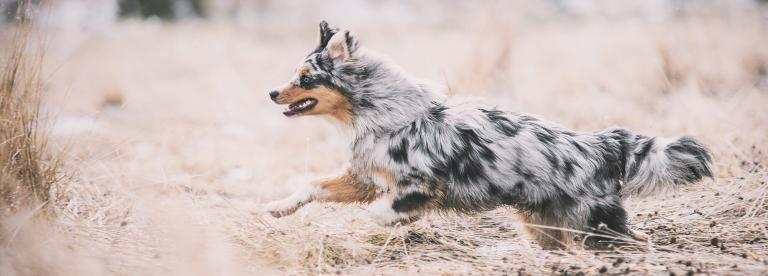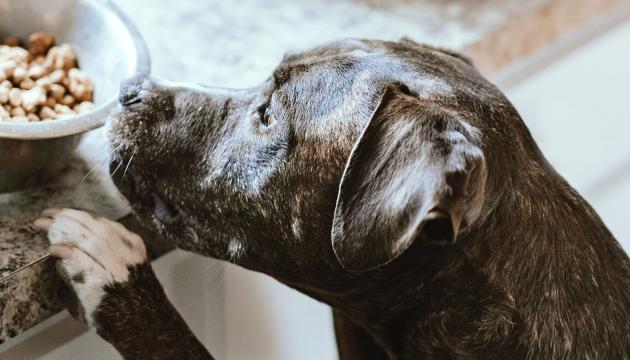

Feeding an active dog
When feeding an active dog, you must be mindful with the food choices. It's all about picking the right fuel to keep your energetic companion going strong during training and help the dog’s muscles recover after a heavy performance. The key is to match the dog’s energy needs just right.
How much food an active dog needs depends on how intense, how long, and how often the dog exercises. You can estimate the dog’s activity level by counting the hours the dog typically moves per day:
- Low activity: less than 1 hour/day
- Normal activity: 1–2 hours/day
- Active: over 2–3 hours/day
- Working or sporting dog: over 3 hours/day
If your furry friend is all about the high-energy activities like agility competitions or heavy-duty work, it needs a specific diet to ensure proper recovery for staying on top of the game. But if your dog only occasionally dabbles in agility training, there is no need to stress about changing up its chow routine. A balanced, basic diet will do the trick just fine.
The food for an active dog should have similar protein and fat content as puppy food. Aim for around 25–30% protein and about 20% fat. And make sure the food is easy on the dog’s tummy, so it gets digested without a hitch. Keep an eye out for any special dietary needs or allergies your dog might have when choosing the food. Read more about choosing the right food for your dog.
The topics of this article are:
- Is active dog food suitable for my home dog?
- Planning the diet for working and sporting dogs
- Feeding an agility dog
Is active dog food suitable for my home dog?
If your dog is getting in a solid 1–2 hours of daily exercise and its hobbies fit right in that timeframe, your dog’s activity level is considered normal. A weekly agility session, a random competition here and there, and regular walks won't really crank up the dog’s energy needs. So, no need to go overboard with the dog’s food. A good high-quality basic diet is usually enough for your dog. You can save the active dog food for the real workout warriors!
An active home dog can have a slightly rounder physique compared to sporty dogs, since their workload is usually lower. With the body condition, aim for a score of around 5 on a scale of 1–9 for your home dog. That's just one notch higher than what's recommended for an agility dog. Ideally, you should be able to feel the dog’s ribs without any trouble, see a nice waistline from above, and notice a gentle curve in their tummy area.
IN FEEDING AN ACTIVE HOME DOG, THE MOST IMPORTANT THING IS TO MAINTAIN THE DOG'S OVERALL FITNESS AND SUITABLE BODY CONDITION SCORE, AND TO ENSURE THAT THE DOG HAS ENOUGH ENERGY FOR BOTH TRAINING AND HOME ACTIVITIES.
PrimaDog offers some great options for your active home dog! You can choose the Grain-free Venison & Turkey or Grain-free Salmon & Potato dry foods, which are spot-on when it comes to protein and fat content. If your four-legged friend needs an extra energy boost, PrimaDog has got your back with our own Grain-free Active Duck & Herring kibble. It's all about finding the right fit, so go ahead and dive into the world of PrimaDog's grain-free dry foods.
You can also give your dog an energy boost by using PrimaDog's sausages for dogs or meat. Explore the possibilities of adding variety in your furry friend's meals.
Planning the diet for working and sporting dogs
Just like with dog feeding in general, the diet for working and sporting dogs is designed to meet their energy requirements. You want them to stay fit and muscular without tipping the scales in the wrong direction. Hence, a carefully planned food for an active dog is a crucial part of maintaining good fitness and endurance.
The diet can be influenced by the dog’s rest and active periods, especially for hunting dogs. It is all about understanding their unique needs and making sure they are fuelled up right for those specific times of rest and action.
When figuring out how to feed your working or sporting dog, start by considering their level of physical activity. You can break it down into two main categories: short but intense bursts of sprinting and long-haul endurance performances.
Short-duration anaerobic performance
- Examples: agility run and sighthound races.
- The actual performance does not use up a ton of energy since it is short. But the training for the competitions ramps up the dog’s energy needs.
- When dogs go all-out with anaerobic performance, their body does not get enough oxygen, so it produces lactic acid and taps into glucose for fuel. Glucose forms glycogen stores which are the storage form of carbohydrates.
Long-duration aerobic performance
- Examples: hunting and long-distance sled dog races.
- Covering a long distance at a low pace makes the dog’s body crave oxygen and significantly increases the dog's energy expenditure.
- The dog's main energy source is fat, which takes the spotlight during endurance performances. Without fat, the dog's body does not have the energy to keep up the long-lasting effort.
The physique of a sporting and working dog is influenced by both genetics and the environment. This means everything from their exercise routine to what they eat during their growth phase plays a role. If you are aiming for top-notch performances with your furry companion, it is all about providing them diverse exercise during their puppy days to build up basic fitness, muscle strength, and body control. Remember to provide a healthy and varied diet that gives plenty of energy to grow and thrive. Check out more info on how to feed a puppy.
Do you and your four-legged hunting partner hit the great outdoors? Hunting is quite a tough activity, and your trusty companion deserves a proper meal. Check out PrimaDog's guide how to keep your hunting dog well-fed.

Feeding an agility dog
Agility is way more than just competing, which is why the energy requirements for an active agility dog can be high. All that regular training, getting in top physical shape, and doing warm-up and cool-down exercises before and after competitions increase the dog's energy expenditure. These agile canines are always on the move!
During the agility run, the dog performs tight turns, quick bursts of speed, sudden stops, and high jumps. It is a real workout, and it puts strain on the dog’s joints and tendons. That is why keeping the dog at its ideal weight is crucial, so it does not put too much stress on its muscles and bones, which can hinder both speed and recovery from the performance. And here is a pro tip: consider going for active dog food that includes joint supplements.
In the 1–9 body condition scale, an ideal for agility dog is 4 which means lean. The dog should have a thin layer of fat covering the ribs, with the ribs being easily felt. The waistline should be clearly visible from the top, and the abdominal line should rise when viewed from the side. However, the dog should not become too thin to prevent a decline in muscle condition.
A DOG NEEDS APPROXIMATELY 0.5 DL OF WATER PER KILOGRAM OF BODY WEIGHT, BUT EXERCISE INCREASES THE DOG'S WATER NEEDS. FOR A MEDIUM-SIZED ACTIVE DOG, THE WATER REQUIREMENT IS ABOUT 1–2 LITERS PER DAY. MOISTENED DRY FOOD, WET FOOD, AND MEAT CAN HELP TO INCREASE THE FLUID INTAKE.
Agility run lasts about 1–2 minutes, which only bumps up the dog's energy needs by about 10–20%. But here's the thing: training sessions and physical exercises can be quite the marathon. That is why it is smart to go for a dog food that is tailor-made for active dogs, giving them the right amount of protein and fat. It is like a power-up for their body, providing the energy they need and important amino acids to repair hard-working muscles.
Make sure to feed the dog several hours before agility run, so the dog’s energy stores are full, but stomach is empty.
Did you know that PrimaDog Active Duck & Herring dog food is designed in collaboration with the Finnish Agility Association? The Active dry food contains 30% protein and 22% fat, with 80% of the protein being animal based. We added supplements to support the dog's joint health, and our recipe is totally on point, considering the strain the muscles go through. It is all about taking care of your agile superstar!





